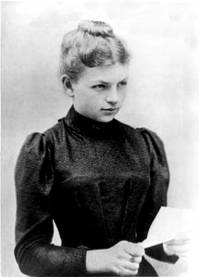


Clara Immerwahr broke up because of the misogynist scientific system and because of her marriage to the famous chemist Fritz Haber. After the birth of their son she was forced to give up her Career in research. She committed suicide at the age of 44.
Clara Immerwahr was born on June 21, 1870 as the youngest of four children of the chemist Philipp Immerwahr and his wife Anna on the Oswitz estate in Polkendorf in Lower Silesia (now Wojczyce in Polish). The father ran the farm and experimented with artificial fertilizers.
In the summer the Immerwahrs lived on the estate, where the children received private lessons. In winter they lived in Breslau, 25 kilometers away, at that time the third largest city in the German Empire with 240,000 inhabitants. Here the three daughters attended a girls' high school. Its liberal director recognized Clara's natural scientific talent, encouraged her interest in chemistry and gave her a specialist book with the title "Conversations on Chemistry". Immerwahr first achieved the highest educational qualification for women as a teacher and worked temporarily as a so-called governess, because at that time women were hardly able to penetrate the domain of science. Even high school and university studies were considered a male privilege.
With their intelligence and moral courage, with tenacity and hard work, Immerwahr prevailed. She attended the University of Wroclaw as a guest student. A physics professor made it clear that he ?don't believe in spiritual Amazons?, but he could not put off Immerwurst. She concentrated on chemistry and gained access to the laboratories to experiment there. The Breslau professor Richard Abegg (1869-1910), chemist and pioneer of valence theory and the octet rule, recognized their abilities. He became her academic mentor and later her PhD advisor. In the beginning, Immerwahr assisted him in experimenting. After she had passed the Abitur as an external student at a boys' high school in 1897, she was allowed to enroll as a full student. Three years later, at the age of 30, she received her doctorate magna cum laude in physical chemistry. The ?Provinzial-Zeitung? of Breslau reported on December 22nd, 1900: ?Our first female doctor. On Saturday noon at 12 noon, Miss Immerwahr's doctorate took place in the Aula Leopoldina of our alma mater. ?Immerwahr was the first German female chemist with a doctorate - although not the first female chemist to receive a doctorate in Germany. The Russian chemist Julia Lermontowa (1847-1919) had already received her doctorate from the University of Göttingen in 1874.
After completing her dissertation, Immerwahr first took up an unpaid assistant position. She had once turned down a marriage proposal from her former dance class friend Fritz Haber (1868-1934). But when she met Haber, who had also studied chemistry in Breslau, again, he asked again for her hand. This time Immerwahr agreed and the two married in 1901. They dreamed of a marriage based on the model of Marie Sk?odowska Curie (1867-1934) and her husband Pierre Curie (1859-1906), who researched and lived together in Paris.
The enthusiasm for chemistry was not the only thing that Immerwahr and Haber had in common. Both came from Jewish families in Breslau, but had already converted to Protestantism before the wedding. At the time of the marriage, Haber was teaching and researching as an associate professor at the Technical University of Karlsruhe. Immerwahr worked in his laboratory until his son Hermann was born in 1902. While Haber continued to immerse himself in science, Immerwahr felt restricted in the role of housewife, mother and representative professor's wife. In 1909 she wrote to her doctoral supervisor Abegg: "What Fritz has gained in these eight years, I have lost - and more - and what is left of me fills me with the deepest dissatisfaction." Her hopes, more again getting involved in her husband's research did not materialize.
In 1910 the family moved from Karlsruhe to Berlin-Dahlem, where Haber became director of the Kaiser Wilhelm Institute for Physical Chemistry and Electrochemistry . After the beginning of World War I, he began to experiment with war gases and played a key role in planning their use as a weapon of mass destruction. Immerwahr, however, publicly called the development of poison gases a "perversion of science". The marriage got into an increasingly severe crisis, until the once self-confident and assertive chemist no longer knew a way out. On May 2, 1915, Clara Immerwahr shot herself with her husband's service weapon in the garden of the villa on Moltkestrasse. In January 1937, her son Hermann had her urn transferred to his father's grave in the Basel cemetery on the Hörnli. Fritz Haber, who received the Nobel Prize in Chemistry in 1918 for the synthesis of ammonia from nitrogen and hydrogen, emigrated to England in 1933 and died of heart failure in a hotel in Basel in 1934 while traveling to Israel.
Although Clara Immerwahr took the name of her husband after the marriage, she is mentioned in the literature - and therefore also in this text - by her maiden name. She became known to a broad audience in 2014 through the ARD television film ?Clara Immerwahr?, which traces her life story and primarily addresses the misogyny in science at the beginning of the 20th century.
a notice
The texts published in this series do not claim to be scientific publications. Authors and other people involved are not experts in the history of science. The purpose of the series is to introduce the mostly unknown women chemists and to remind you of the well-known women chemists. We encourage readers who want to know more to study academic Literature on the women featured. In some cases there are detailed chemical-historical works.
authors
Prof. Dr. Eberhard Ehlers
Prof. Dr. Heribert Offermanns
Editorial processing
Dr Uta Neubauer
project management
Dr Karin J. Schmitz (GDCh public relations)
The authors are responsible for the content of the biographies.
The content presented on these pages has been carefully compiled. However, the authors, Editorial staff and publishers assume no responsibility or liability for the completeness and correctness of the content or for typographical errors.
(Photo: Unknown author, Clara Immerwahr, marked in the public domain, details on Wikimedia Commons )
back to overview biographies of women chemists
back to publications
This page has been machine translated. If you have any feedback or comments please feel free to contact us. 
last modified: 10.05.2021 16:19 H from N/A